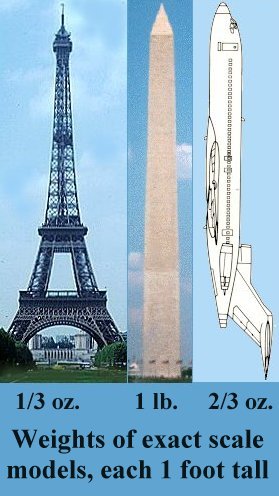Members in Tension
Today, we design for tension. The University of Houston's College of Engineering presents this series about the machines that make our civilization run, and the people whose ingenuity created them.
I'd like to try an idea on you. The Washington Monument is 555 feet high, and it weighs 81 thousand tons. The Eiffel Tower, nearly twice as tall, weighs only ten thousand tons. Now, scale each down to a height of one foot, reducing every part in precise proportion. The Washington Monument model will weigh one pound, but the Eiffel Tower model will weigh an incredible 1/3th of an ounce.
What on earth can be so different about the two structures? The steel in the Eiffel Tower is three times as dense as the granite in the Washington Monument. Shouldn't it be far heavier?
The Washington Monument is the tallest masonry structure ever built. It pushes an upper limit to masonry. Stone will resist as much loading as steel will in compression, but it's weak in tension. The stone in the Washington Monument carries immense compressive loads near the bottom, but almost no tension. It's only squeezed; it's not pulled.
The steel Eiffel Tower, on the other hand, distributes forces throughout a gossamer network of beams. A single beam might carry tension on top and be compressed on the bottom. It's contrived so that every element in a complex structure serves the whole.
The Washington Monument was finished in 1885. That was the same year the first tall steel-frame building went up -- the nine-story Chicago Home Insurance Building. But those two structures marked an architectural passing of the torch. After that, real height would be achieved with the use of light steel frames. The Eiffel Tower was finished only four years later.
Tall steel-framed buildings weren't the only such idea to come out of Chicago. Fifty years earlier, the construction used in your house also originated there -- the familiar idea of making houses from light two-by-four studs crisscrossed with even lighter pieces of wood. That's come to be called the Chicago Balloon Frame.
Before the 1830s, houses were built with heavy interlocking beams. The first balloon frames looked as light and gossamer as the Eiffel Tower. They were its predecessor, for they distributed forces with the same efficiency as Eiffel's girders. Since then, all kinds of things have been built that way. Bridges were first, then houses, skyscrapers, and finally airplanes.
A Boeing 727 has to withstand far nastier stress than the Eiffel Tower. It bears the huge forces of aerodynamics and of its own engines. But those forces flow through its members, right down to the stressed aluminum skin around it. Reduce a 727 to the size of that Eiffel Tower model, and it will weigh only twice as much -- two thirds of an ounce instead of just one third.
So a new idea changed everything in the nineteenth century. It seems paradoxical that the very density of new and available metals is what led to a whole new lightness of being.
I'm John Lienhard, at the University of Houston, where we're interested in the way inventive minds work.
(Theme music)
For sources here I have gone to a variety of standard data sources including encyclopedias and the Internet. See also various links within the text. Fellow Texans might wonder about the San Jacinto Monument which stands twelve feet taller than the Washington Monument. Finished 54 years later, it is not masonry, but steel-reinforced concrete -- a hybrid between masonry and steel frame construction. Consequently, it is much lighter; 2/5 as heavy as a corresponding masonry structure. It does correctly boast being the tallest "monument column" in the world.
